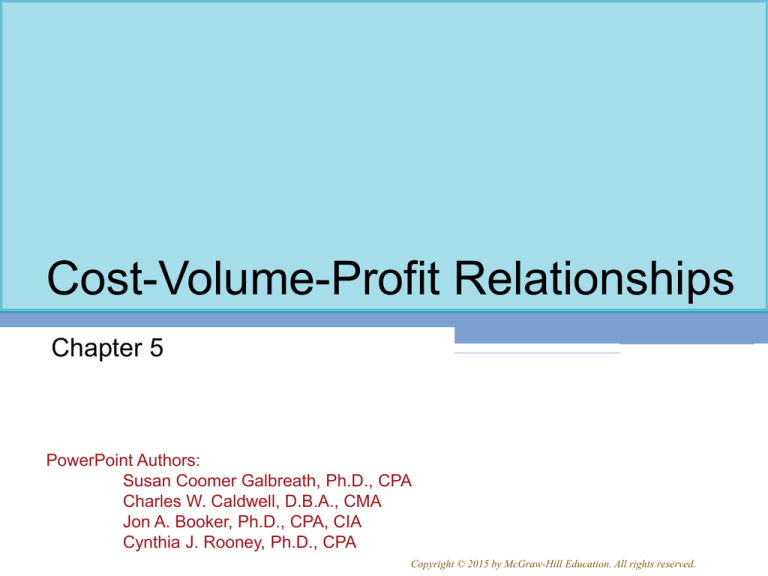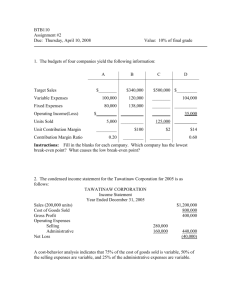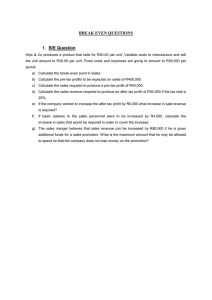
Cost-Volume-Profit Relationships
Chapter 5
PowerPoint Authors:
Susan Coomer Galbreath, Ph.D., CPA
Charles W. Caldwell, D.B.A., CMA
Jon A. Booker, Ph.D., CPA, CIA
Cynthia J. Rooney, Ph.D., CPA
Copyright © 2015 by McGraw-Hill Education. All rights reserved.
5-2
Key Assumptions of CVP Analysis
1. Selling price is constant.
2. Costs are linear and can be accurately
divided into variable (constant per unit) and
fixed (constant in total) elements.
3. In multiproduct companies, the sales mix is
constant.
4. In manufacturing companies, inventories do
not change (units produced = units sold).
5-3
Basics of Cost-Volume-Profit Analysis
The contribution income statement is helpful to managers
in judging the impact on profits of changes in selling price,
cost, or volume. The emphasis is on cost behavior.
Racing Bicycle Company
Contribution Income Statement
For the Month of June
Sales (500 bicycles)
$
250,000
Less: Variable expenses
150,000
Contribution margin
100,000
Less: Fixed expenses
80,000
Net operating income
$
20,000
Contribution Margin (CM) is the amount remaining from
sales revenue after variable expenses have been deducted.
5-4
The Contribution Approach
Sales, variable expenses, and contribution margin
can also be expressed on a per unit basis. If Racing
sells an additional bicycle, $200 additional CM will
be generated to cover fixed expenses and profit.
Racing Bicycle Company
Contribution Income Statement
For the Month of June
Total
Per Unit
Sales (500 bicycles)
$
250,000
$
500
Less: Variable expenses
150,000
300
Contribution margin
100,000
$
200
Less: Fixed expenses
80,000
Net operating income
$
20,000
5-5
The Contribution Approach
Each month, RBC must generate at least
$80,000 in total contribution margin to break-even
(which is the level of sales at which profit is zero).
Racing Bicycle Company
Contribution Income Statement
For the Month of June
Total
Per Unit
Sales (500 bicycles)
$
250,000
$
500
Less: Variable expenses
150,000
300
Contribution margin
100,000
$
200
Less: Fixed expenses
80,000
Net operating income
$
20,000
5-6
The Contribution Approach
If RBC sells 400 units in a month, it will be
operating at the break-even point.
Racing Bicycle Company
Contribution Income Statement
For the Month of June
Total
Per Unit
Sales (400 bicycles)
$
200,000
$
500
Less: Variable expenses
120,000
300
Contribution margin
80,000
$
200
Less: Fixed expenses
80,000
Net operating income
$
-
5-7
CVP Relationships in Equation Form
It is often useful to express the simple profit equation in
terms of the unit contribution margin (Unit CM) as follows:
Unit CM = Selling price per unit – Variable expenses per unit
Unit CM = P – V
Profit = (P × Q – V × Q) – Fixed expenses
Profit = (P – V) × Q – Fixed expenses
Profit = Unit CM × Q – Fixed expenses
5-8
CVP Relationships in Graphic Form
The relationships among revenue, cost, profit, and volume
can be expressed graphically by preparing a CVP graph.
Racing Bicycle developed contribution margin income
statements at 0, 200, 400, and 600 units sold. We will
use this information to prepare the CVP graph.
Units Sold
200
0
Sales
$
-
$
100,000
$
400
200,000
600
$
300,000
Total variable expenses
-
60,000
120,000
180,000
Contribution margin
-
40,000
80,000
120,000
80,000
80,000
80,000
80,000
Fixed expenses
Net operating income (loss)
$
(80,000)
$
(40,000)
$
-
$
40,000
5-9
Preparing the CVP Graph
Break-even point
(400 units or $200,000 in sales)
$350,000
Profit Area
$300,000
$250,000
$200,000
Sales
Total expenses
Fixed expenses
$150,000
$100,000
$50,000
$0
0
Loss Area
100
200
300
400
Units
500
600
5-10
Contribution Margin Ratio (CM Ratio)
The CM ratio is calculated by dividing the total
contribution margin by total sales.
Racing Bicycle Company
Contribution Income Statement
For the Month of June
Total
Per Unit
Sales (500 bicycles)
$ 250,000
$ 500
Less: Variable expenses
150,000
300
Contribution margin
100,000
$ 200
Less: Fixed expenses
80,000
Net operating income
$
20,000
CM Ratio
100%
60%
40%
$100,000 ÷ $250,000 = 40%
Each $1 increase in sales results in a total contribution
margin increase of 40¢.
5-11
Contribution Margin Ratio (CM Ratio)
The relationship between profit and the CM ratio
can be expressed using the following equation:
Profit = (CM ratio × Sales) – Fixed expenses
If Racing Bicycle increased its sales volume to 500
bikes, what would management expect profit or net
operating income to be?
Profit = (40% × $250,000) – $80,000
Profit = $100,000 – $80,000
Profit = $20,000
5-12
Break-even in Unit Sales:
Formula Method
Let’s apply the formula method to solve for
the break-even point.
Unit sales to
=
break even
Fixed expenses
CM per unit
$80,000
Unit sales =
$200
Unit sales = 400
5-13
Equation Method
Profit = Unit CM × Q – Fixed expenses
Our goal is to solve for the unknown “Q” which
represents the quantity of units that must be sold
to attain the target profit.
5-14
Target Profit Analysis
Suppose RBC’s management wants to know
how many bikes must be sold to earn a target
profit of $100,000.
Profit = Unit CM × Q – Fixed expenses
$100,000 = $200 × Q – $80,000
$200 × Q = $100,000 + $80,000
Q = ($100,000 + $80,000) ÷ $200
Q = 900
5-15
The Formula Method
The formula uses the following equation.
Unit sales to attain
Target profit + Fixed expenses
=
the target profit
CM per unit
5-16
Target Profit Analysis in Terms of
Unit Sales
Suppose Racing Bicycle Company wants to
know how many bikes must be sold to
earn a profit of $100,000.
Unit sales to attain
Target profit + Fixed expenses
=
the target profit
CM per unit
$100,000 + $80,000
Unit sales =
$200
Unit sales = 900
5-17
The Margin of Safety in Dollars
If we assume that RBC has actual sales of
$250,000, given that we have already
determined the break-even sales to be
$200,000, the margin of safety is $50,000 as
shown.
Break-even
sales
400 units
Sales
$ 200,000
Less: variable expenses
120,000
Contribution margin
80,000
Less: fixed expenses
80,000
Net operating income
$
-
Actual sales
500 units
$ 250,000
150,000
100,000
80,000
$
20,000
5-18
Cost Structure and Profit Stability
Cost structure refers to the relative proportion
of fixed and variable costs in an organization.
Managers often have some latitude in
determining their organization’s cost structure.
5-19
Operating Leverage
Operating leverage is a measure of how sensitive
net operating income is to percentage changes
in sales. It is a measure, at any given level of
sales, of how a percentage change in sales
volume will affect profits.
Degree of
operating leverage
Contribution margin
= Net operating income
5-20
End of Chapter 5




